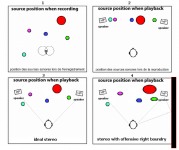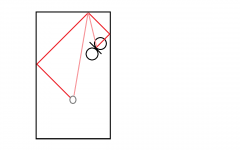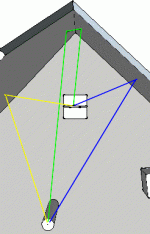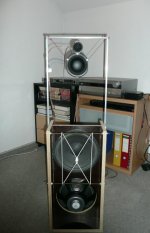... I’d rather go for listening to less recordings in best quality than more recordings in compromised quality.
...
Hi Rudolf,
completely agreed, if speaking for myself solely.
But in a "home speaker" some tolerance for even mediocre recordings
seems desirable also ( seen as "extent of the subset of enjoyable recordings
among owned ones").
It is part of a natural decision for purchase.
So the warning "Do not listen to mediocre recordings !" should
not be printed in too big letters on the front cover of the speaker ...
I think that an earlier post from Earl Geddes sums it all up: you'll want to avoid very early reflections, < 10 ms or maybe even a bit more, to preserve imaging and avoid coloration. On the other hand later lateral reflections (> 10 ms or even > 80 ms, as I conclude from Toole) are necessary to provide spaciousness/LEV.
Later reflections are beneficial because we use them to extract more information about the source. The music gains body and fullness and a more natural timbre.
Often recorded reflections only are not enough for a proper sense of spaciousness with a stereo system, because we cannot process them as well as real reflections arriving from different angles. You can easily test this by making a recording with a standard 110 deg stereo mic in a reverberant space such as a lecture hall and then playing it back over a stereo set. You'll hear much more reverberation than live and often speech is no longer intelligible.
In Toole we read that most "naive" listeners prefer early lateral reflections to an absence thereof. However, looking at figure 7.2, we can conclude that this is not the optimal situation since listeners actually prefer reflections with a longer delay than in a typical room!
I listen to a dipole which is toed in 45 degrees in a somewhat Geddes-like setup, with the rear wave reflected and delayed via multiple walls to the listener and the nulls towards the side walls (see attachment).
Later reflections are beneficial because we use them to extract more information about the source. The music gains body and fullness and a more natural timbre.
Often recorded reflections only are not enough for a proper sense of spaciousness with a stereo system, because we cannot process them as well as real reflections arriving from different angles. You can easily test this by making a recording with a standard 110 deg stereo mic in a reverberant space such as a lecture hall and then playing it back over a stereo set. You'll hear much more reverberation than live and often speech is no longer intelligible.
In Toole we read that most "naive" listeners prefer early lateral reflections to an absence thereof. However, looking at figure 7.2, we can conclude that this is not the optimal situation since listeners actually prefer reflections with a longer delay than in a typical room!
I listen to a dipole which is toed in 45 degrees in a somewhat Geddes-like setup, with the rear wave reflected and delayed via multiple walls to the listener and the nulls towards the side walls (see attachment).
Attachments
a_tewinkel, did you ever try to minimize the contralateral reflection while maximizing the ipsilateral one?
I've experimented a lot with the toe-in. I prefer this setup, but I find the difference with a 0 deg setup not very large. You do lose some image width with the 45 deg setup, but I think it sounds a little more spacious and enveloping. They're several meters from the rear wall by the way.
By the way, other people might prefer a different setup due to adaptation and learned preferences. That's probably one of the reasons why consensus will probably never be reached here. But that's perfectly okay.
By the way, other people might prefer a different setup due to adaptation and learned preferences. That's probably one of the reasons why consensus will probably never be reached here. But that's perfectly okay.
By "toeing out" a dipole ?
That would raise the level of contralateral reflections but depending on the setup it could work.
It's somewhat hard to get there with a dipole but my idea was to create a second order reflection, first hitting the front wall and then the ipsilateral wall.
Last edited:
Although I sort of agree, if recording were made such that image localization timing or phase cues existed between 100HZ and 1kHZ, any playback system that doesn't have inter-aural cancellation would just corrupt the info anyway (I've tried it). Plus, embedded interaural cancellation has to pick a delay time, roughly 125uS, and that will determine where the sweet spot is. the chances of it being right for most setups is slim (I tried that too). Ideally, the delay time would be adjustable, but even then, I have two friends, one of which is a hard core audio engineer, who refuse to sit in the sweet spot on principal alone. Personally though, since I do use a variation of the Carver circuit for inter-aural cancellation, I would love it if a pan pot also varied the 100HZ - 1kHZ reverb signature consistent with what the amplitude is doing in the upper midrange. The subtle emotional impact is very nice. Each instrument seems to have its own acoustic space, very distinct from others.Pan-potted stereo really needs to die, it just doesn't sound any good and has a very narrow sweet spot with the range of localizable images remaining between the speakers, clearly there are far superior encoding systems being used on some recordings, but we as listeners don't know what techniques were used on what recordings, thus greatly confusing the whole discussion about imaging, envelopment, and what speaker/room configurations are need to get it. (With what type of recording ? etc...)
I've got both, sort of, because I've got vertical line array midrange drivers and a variation of the Carver circuit doing inter-aural cancellation. In the sweet spot I've got great spaciousness, and when you are off axis, open baffle/dipole speakers illuminate the room more than most conventional speakers.I'll take both pills, I like spaciousness and imaging.
That would raise the level of contralateral reflections but depending on the setup it could work.
It's somewhat hard to get there with a dipole but my idea was to create a second order reflection, first hitting the front wall and then the ipsilateral wall.
What could be beneficial effects you seem to be thinking of ?
Member
Joined 2009
I will utilize the figure used earlier to make some points of my own. Since there's some ambiguity over what stereo is supposed to portray I'd like to check my understanding against others.

The relative distance to 2 microphones should not only give cues on the left-right axis but also depth. We can certainly discern at what distance a sound originated, this should be true when listening to a phantom image as well. It must be noted that the left-right and depth information are not absolute, so the original position of the sources can never be restored. An ideal stereo image should spread out the sources to their relative positions in a similar manner as illustrated in Figure3.
In a realistic environment the stereo image becomes smeared as shown in Figure4 or collapses completely. There is also some disagreement over whether the stereo image forms in front of the speakers or behind but I suspect that might be influenced by the front wall.

The relative distance to 2 microphones should not only give cues on the left-right axis but also depth. We can certainly discern at what distance a sound originated, this should be true when listening to a phantom image as well. It must be noted that the left-right and depth information are not absolute, so the original position of the sources can never be restored. An ideal stereo image should spread out the sources to their relative positions in a similar manner as illustrated in Figure3.
In a realistic environment the stereo image becomes smeared as shown in Figure4 or collapses completely. There is also some disagreement over whether the stereo image forms in front of the speakers or behind but I suspect that might be influenced by the front wall.
Member
Joined 2009
Another phenomena I've witnessed is that the width of the stereo image can be varied with the amount of toe-in. It can be confined between the speakers or widened out further than them.
What could be beneficial effects you seem to be thinking of ?
I believe that some reflections have to form a certain relationship when the classic stereo triangel is used. The contralateral reflection being above a certain level will result in a very narrow stage. Ipsilateral reflections can produce a very wide stage. The higher the level, the wider the stage.
The transition from real sound sources (signal hard panned to one speaker) to phantom sources is probably perceptually mitigated by reflections.
Another phenomena I've witnessed is that the width of the stereo image can be varied with the amount of toe-in. It can be confined between the speakers or widened out further than them.
What toe-in corresponds to what stage width for you?
Except two conventional microphones or a stereo microphone do not work the same way as two ears.The relative distance to 2 microphones should not only give cues on the left-right axis but also depth. We can certainly discern at what distance a sound originated, this should be true when listening to a phantom image as well.
Although time delay between the ears plays a part in identifying the azimuth of a sound source this effect only occurs below about 800Hz, and for higher frequency components its done by the HRTF,. Since normal microphones have no human-like HRTF a large percentage of the possible image localization cues are lost right from the start when recording in this fashion.
This is before you even consider corruption in the playback system - for example reflections from walls.
If you haven't already, its well worth looking at the sound perception links posted a couple of pages ago, which include test sounds that help demonstrate some of the points they discuss:
Introduction to Psychoacoustics - Module 08A
Introduction to Psychoacoustics - Module 08B
Is this, what you are looking for? Very week first ipsilateral reflection (yellow), strong second ipsilateral reflection (green), week frontwall reflection (blue). Pole is listening position.I believe that some reflections have to form a certain relationship when the classic stereo triangel is used. The contralateral reflection being above a certain level will result in a very narrow stage. Ipsilateral reflections can produce a very wide stage. The higher the level, the wider the stage.
Attachments
Member
Joined 2009
What toe-in corresponds to what stage width for you?
To be completely honest I can't remember with certainty. I heard it when I was setting up my speakers and did not examine it further than finding the most satisfactory position for my taste. I'd like to run a few tests and get back at you with some data. Maybe tonight.
Would anyone like to link some test material?
Is this, what you are looking for? Very week first ipsilateral reflection (yellow), strong second ipsilateral reflection (green), week frontwall reflection (blue). Pole is listening position.
No, I would want yellow the strongest, blue and green nonexistent.
No, I would want yellow the strongest, blue and green nonexistent.
Don't know if it would work well (I don't think it would), but this is probably achieved easiest with high frontal only directivity, and with the speaker toed out. The degree of toe-out could be chosen such that you get any desired ratio of direct to ipsilateral reflected sound. Have you tried it with your Geddes speakers?
check out also this article by EJ Jordan for Wireless World, February 1971:
http://www.ejjordan.co.uk/PDFs/Jordan_WW_Feb_71.pdf
He discusses cross-in-front setup, center channel setup and even stereolit-like reflecting setups of the kind of Elias' and Radugazon's
Interesting. He discusses about the reflector loudspeaker using separate reflector panels, but I don't see him mentioning that a wall could be used as a reflector ! Maybe it didn't appear to him? 🙄
But even more interesting is the delay line stereo. Any more info about that ? It is mentioned to have virtually perfect stereo prformance. How about that ?
- Elias
Last edited:
Interesting. He discusses about the reflector loudspeaker using separate reflector panels, but I don't see him mentioning that a wall could be used as a reflector ! Maybe it didn't appear to him?
I think that the use of reflector panels was related to the traditional English room decor offering not a lot of bare reflective walls really 😉
But even more interesting is the delay line stereo. Any more info about that ?
unfortunately not 🙁
- Status
- Not open for further replies.
- Home
- Loudspeakers
- Multi-Way
- What is the ideal directivity pattern for stereo speakers?


